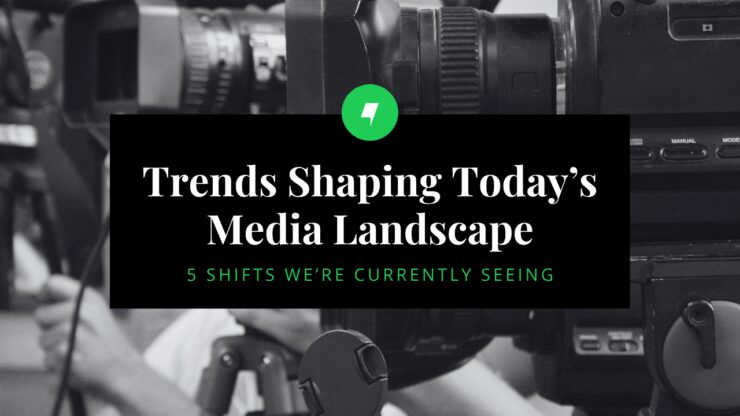The Maven team has recently been busy hosting media training sessions for several clients. This had me thinking about the dramatic shifts the media landscape has undergone in the past few years alone, fundamentally changing the way public relations professionals interact with reporters.
From shrinking newsrooms to the rise of AI-supported journalism, these trends present both opportunities and challenges for organizations seeking to capture media attention and effectively communicate with target audiences.
Below, we explore five recent shifts in the media ecosystem and the impact.
1. Shrinking Newsrooms
It’s no secret that the trend towards smaller newsrooms continues to accelerate, with layoffs, buyouts, and consolidation impacting news outlets nationwide.
The reality:
- Fewer reporters means less capacity for in-depth, investigative stories
- More content is being syndicated from national outlets
- Journalists are stretched thin, expected to cover broader beats and become “experts” across a wider range of topics
The impact:
This presents a significant opportunity for PR and communications teams who understand how to work within these constraints and differentiate themselves. Now more than ever, reporters are looking for thoughtful stories that are comprehensive and well-packaged – think compelling quotes, high-quality images, sourced data, and interview connections.
Additionally, as reporters are more frequently covering topics or stories outside of their traditional “beat,” industry thought leaders can help bridge the gap by serving as a trusted resource.
2. Media Distrust
A 2024 Gallup poll found that confidence in mass media, such as newspapers, broadcast, and radio, has dropped significantly since the early 2000s. While specific data points tend to vary along partisan lines, the overarching trend indicates a growing mistrust in “traditional” media sources.
The reality:
- Media skepticism spans demographics and political affiliations
- Audiences are seeking alternative information sources
- Mass media’s role as an unquestioned third-party validator has weakened
The impact:
This isn’t to say that media coverage isn’t valuable. It just means that there is no “one-size-fits-all” approach to a successful communications campaign – an impactful strategy will consider objectives and target audiences.
For example, thought leaders no longer need to rely exclusively on external media validation to establish credibility. Platforms like LinkedIn for professional content and X for real-time engagement can be a more direct or authentic mechanism for demonstrating expertise and communicating directly with key stakeholders.
3. Media Bias
Analyzing over 1.8 million news headlines from major US outlets between 2014 and 2022, a 2023 study found that news stories, particularly around domestic policy and social issues, have become “increasingly polarized along ideological lines.”
The reality:
- Media outlets and their coverage more regularly reflect distinct ideological perspectives
- Coverage of topics often follows predictable partisan lines
- Audiences seek content that aligns with their personal beliefs
The impact:
PR and communications professionals must think more strategically about media placements. On the one hand, it’s easier than ever to identify journalists and outlets that align with your organization’s viewpoint on specific topics. However, this also creates the risk of reinforcing echo chambers and limiting your potential to reach new audiences.
For example, consistently pitching a story about the impact of DOGE cuts to self-defined progressive publications results in “preaching to the choir” – failing to reach new audiences or change minds.
The uptick in media bias also changes how PR professionals approach interview preparation with our clients. Understanding how reporters and outlets have previously covered topics provides valuable insight into potential questions and story angles. We also recognize that reporters may approach interviews with predetermined narratives, requiring more work and preparation in advance to ensure fair reporting.
4. Decentralized Content & The Creator Economy
Legacy media undoubtedly shares influence with social media influencers, podcasters, and content creators. This is exemplified by the widely-covered impact influencers like Joe Rogan and Alex Cooper played in reaching target voters during the 2024 presidential election.
The reality:
- Audiences, particularly younger demographics, are shifting away from traditional news sources
- To maintain visibility, news outlets continue to invest in social media platforms and vertical video content
- The use of small, bite-sized stories is gaining traction (for example, Axios’ “Sharp Brevity” model)
The impact:
Traditional media outlets remain a critical vehicle for B2B and professional services companies. However, the decentralized media landscape requires expanded thinking about what constitutes a high-value media placement.
Maven, for instance, is increasingly exploring non-traditional outlets – such as a respected industry podcast or specialized online community – to get in front of target audiences. Recognizing there is a change in how reporters tell their stories is also impacting how we package information.
5. AI Integration
No list discussing industry trends would be complete without artificial intelligence, and journalism is no exception. AI is helping to drive efficiency and rapidly transforming day-to-day newsroom operations.
The reality:
- AI enables rapid and vast data analysis, offering new opportunities for in-depth reporting
- Large language models can be used to easily write articles and summarize events – especially for data-centric beats like weather or high school sports
- Journalists have more time to focus on complex, investigative reporting
The impact:
The long-term implications of AI on media relations remains unclear. Will AI help mitigate the effects of shrinking newsrooms by enabling journalists to return to more specialized storytelling? Will we revert to more localized content or further centralized media? How will AI impact media bias and distrust?
The media landscape is evolving rapidly, requiring communication professionals to remain agile and informed. Success in this environment demands the ability to embrace both traditional media relations and emerging opportunities.
Interested in reading more from the Maven team? Check out my recent posts: “Crisis Communications Playbook: Navigating DOGE & Executive Orders” and “The Importance of Message Consistency in a Crisis.”
Posted In Media & Culture, Media Relations
 Emily White
Emily White 